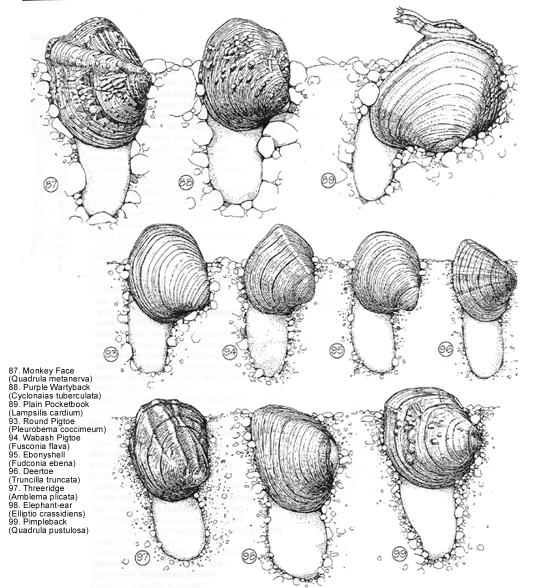Illinois
River and Lake Mussel Habitat Diorama Activity
 Objective:
students will be able to identify and describe the living and environmental
elements of river and lake mussel habitats at the time before settlement
and industrialization.
Objective:
students will be able to identify and describe the living and environmental
elements of river and lake mussel habitats at the time before settlement
and industrialization.
Grades:
2-7
Time Required:
- teacher-guided tour through the Harvesting the river online exhibit
section on mussels and fish species
-
look at the mussel shell collection online of 81 specimens of Illinois
mussels; this is supplemental to classroom instruction and discussion
of river and lake habitat. This could also be a post-visit activity
with a field trip to the Changes exhibit at the Illinois
State Museum in Springfield, where there is a full-scale diorama of
a mussel habitat.
Online Resources:
Harvesting
the River Online Exhibit (sections on Harvesting, mussels, fish;
photo gallery)
Illinois Mussels Collection Online (photo gallery, introductory
text on mussels, article on mussels)
Materials:
Computer, Internet connection, printer
Photocopier
Printouts of plant and animal graphics
Coloring media - crayons, pencils, paint
Shoebox or other diorama box or stage
Scissors
Dirt, sand, gravel
Kraft paper to sculpture landforms
Gluestick and glue
Motivation:
When studying river habitats, it is important to understand the interdependence
and interconnections among many types of plants and animals that share
an ecosystem. Underwater habitats are difficult to visit in person.
The Illinois State Museum's new first-floor exhibit, Changes,
opening in 2004, offers an opportunity to view such a habitat in the
form of a life-size diorama. Students could do this activity as a post-museum-visit
lesson to reinforce what they learned. If students are unable to visit
the museum, their making this diorama gives them an opportunity to visualize
the habitat they are studying. Also see other ISM lessons on mussel
anatomy and life cycle. The diorama could be an individual or group
project and vary in size accordingly.
Procedure:
Students will:
1) become familiar with the materials in the Harvesting the River
and ISM Mussel Collection Online introductory text and
images
2) discuss the animals and plants found in the mussel habitat and how
they interact and interconnect
3) identify and color the plants and animals in the printouts
4) construct the environment of their diorama, contouring the land and
riverbed or lakebed and adding soil types
5) place and glue their plants and animals in the diorama according
to the descriptions of each animals habitat (i.e. mussels bury themselves
halfway into the mud of the riverbed leaning upstream)
6) add any finishing creative touches to their diorama (water effects
with plastic wrap, etc)
7) review to themselves the characteristics, life cycles, habitat, and
interconnections of the living and non-living components of their diorama
habitat.
Assessment:
The diorama arrangement should demonstrate an understanding of where
(river or lake) each animal and plant lives in relation to others, and
what each basically looks like (green leaves, brown shell, etc.). For
example, mussels should be partially buried in the lakebed or streambed.
The student discussion or description should demonstrate knowledge of
the characteristics of the living species and their relationship to
their environment.
Illinois State
Board of Education Goals Addressed:
Science: Concepts and Principles
Early Elementary:
12.A.1a: Identify and describe the component parts of living things
(e.g., birds have feathers; people have bones, blood, hair, skin) and
their major functions.
12.A.1b: Categorize living organisms using a variety of observable
features (e.g., size, color, shape, backbone).
12.B.1a: Describe and compare characteristics of living things
in relationship to their environments.
12.B.1b: Describe how living things depend on one another for
survival.
Late Elementary:
12.A.2a: Describe simple life cycles of plants and animals and
the similarities and differences in their offspring.
12.B.2a: Describe relationships among various organisms in their
environments (e.g., predator/prey, parasite/host, food chains and food
webs).
12.B.2b: Identify physical features of plants and animals that
help them live in different environments (e.g., specialized teeth for
eating certain foods, thorns for protection, insulation for cold temperature).
Diagrams of
Animals and Plants in Mussel Habitats are in the PDF version
of this lesson.
NOTE: these are not drawn to scale. Students can view them to redraw
them to scale for their diorama or estimate the size according to facts
about the plants' or animals' sizes.

